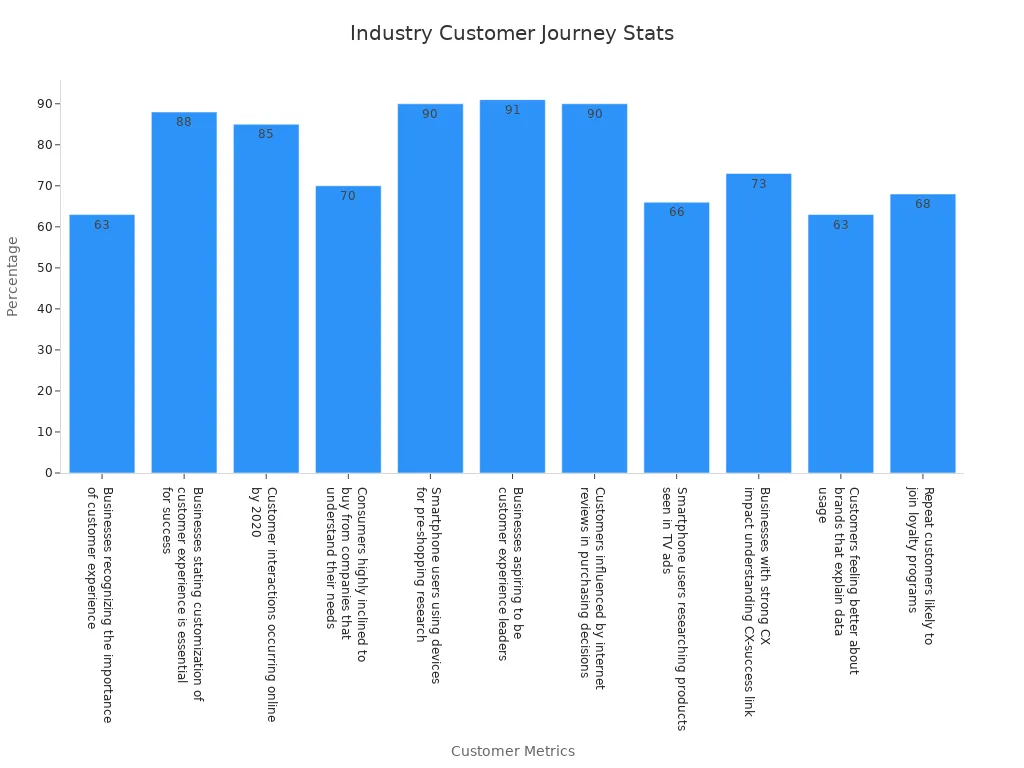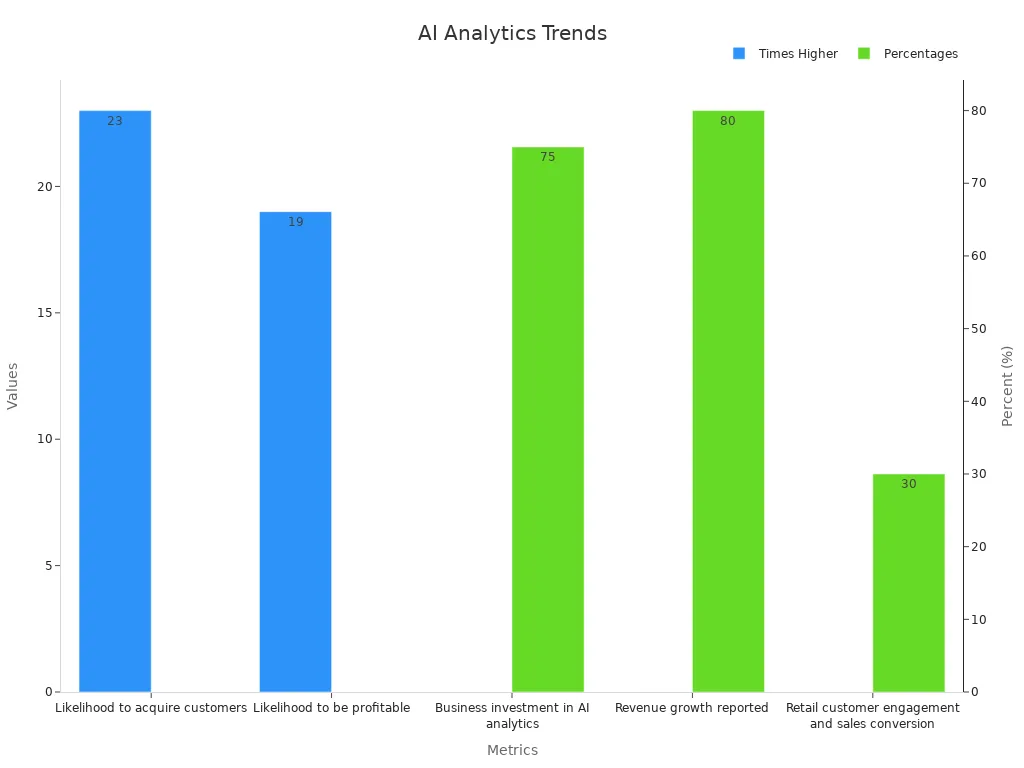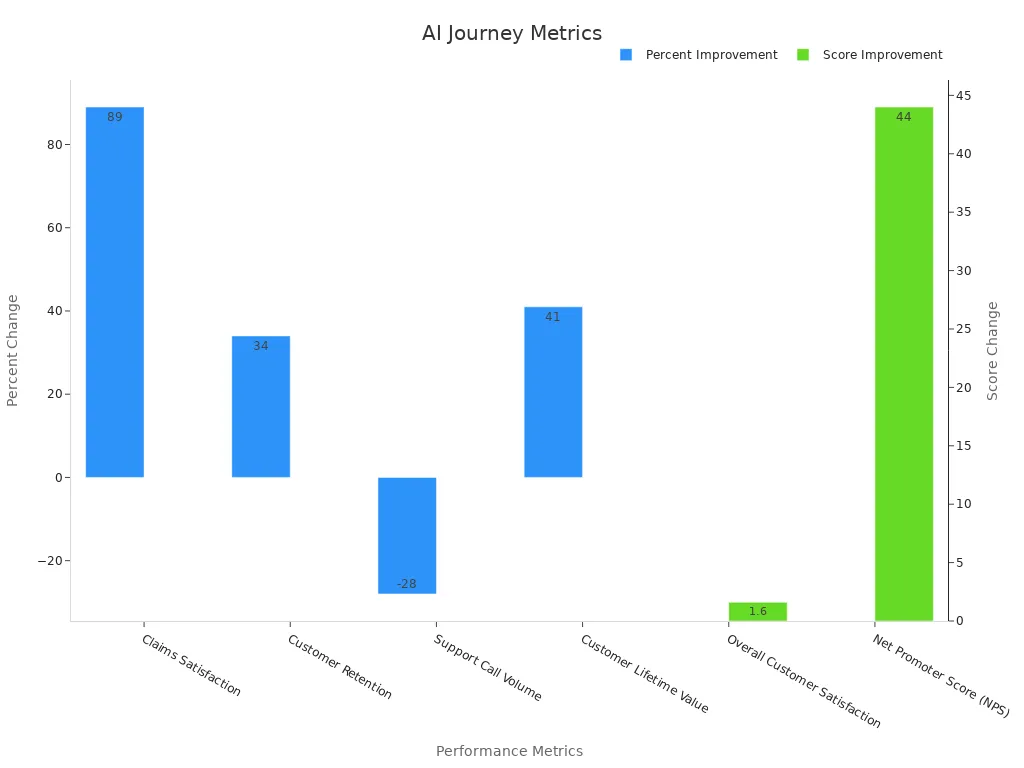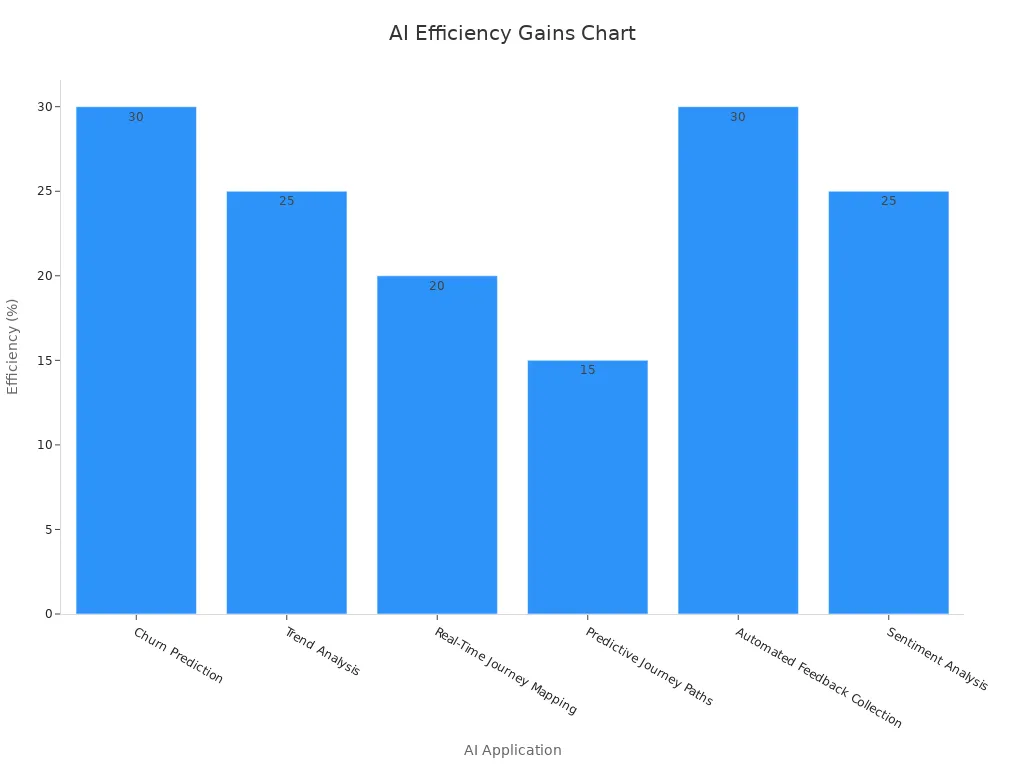Using AI to Map the Full Customer Journey

Do you know all the steps your customers take with your brand? AI can help you follow the whole customer journey. It uses real-time insights, predictive analytics, and personalized experiences. Many businesses notice big changes because of this new way.
Statistic Description | Percentage / Ratio |
|---|---|
Executives believing AI enhances competitive advantage | |
Companies incorporating AI in customer journey analytics | 5% (1 in 20) |
AI takes the place of slow, manual mapping. It uses dynamic, data-driven analysis.
Machine learning finds hidden patterns. It also predicts what customers want.
Sentiment analysis shows how your customers feel at each step.
Key Takeaways
AI lets businesses see each step customers take. It gives quick updates to help make things better fast.
Using AI for customer journey mapping saves time. It also finds hidden patterns that people may not see.
Predictive analytics with AI helps you guess what customers need. You can fix problems before they happen.
Personalizing customer interactions with AI helps build trust. It also helps increase sales and keeps customers coming back.
Mixing AI with human feedback makes customer journey maps more correct. It also helps keep them fair and useful.
Customer Journey Mapping

What It Is
The customer journey is the path people take with your brand. It starts when they first hear about you. It ends when they become loyal fans. This journey has many steps. People might see an ad or read reviews. They could visit your website or buy something. They may also give feedback. Every step changes how they feel about your business.
Mapping the customer journey means you follow these steps. You gather data from places like social media and support chats. You also use surveys. This map helps you see where customers are happy or upset. You can find the most important moments. These are times when someone buys something or needs help after buying.
Why It Matters
When you map the customer journey, you learn what people want. You also learn what they need. This helps you make better experiences. You can fix problems before they get bigger. Many businesses use analytics and AI to do this faster. These tools help you guess what customers might do next. They also show how customers feel at each step.
Tip: AI gives you real-time insights. This lets you change your plan fast. You can keep customers happy and loyal.
Here is a table that shows why mapping the customer journey matters for businesses today:
Statistic Description | Percentage / Value |
|---|---|
Businesses recognizing the importance of customer experience | 63% |
Businesses stating customization of customer experience is essential for success | 88% |
Customer interactions occurring online by 2020 | 85% |
Consumers highly inclined to buy from companies that understand their needs | 70% |
Smartphone users using devices for pre-shopping research | 90% |
Businesses aspiring to be customer experience leaders | 91% |
Customers influenced by internet reviews in purchasing decisions | 90% |
Smartphone users researching products seen in TV ads | 66% |
Businesses with strong CX impact understanding CX-success link | 73% |
Customers feeling better about brands that explain data usage | 63% |
Repeat customers likely to join loyalty programs | 68% |

Most businesses want to be leaders in customer experience. Many customers want brands to know and meet their needs. Mapping the customer journey helps you find problems and make service better. It also helps you build stronger relationships. This way, you can stay ahead when most things happen online.
Traditional vs. AI Approaches
Manual Limitations
When you map the customer journey by hand, it is hard. You have to get data from many places. People often use spreadsheets or sticky notes for this. This takes a lot of time and effort. It is easy to miss important details. You might not notice patterns in what customers do. Manual mapping gives you a picture that does not change. It will not update if your customers act differently.
It is also tough to keep up with changes as they happen. If a customer writes a review or sends a message, you may not see it right away. Manual ways make it hard to connect all the pieces. You can miss big moments that matter in the customer journey.
Note: Manual mapping can cause mistakes and missed chances. You might not find problems until it is too late.
AI Advantages
AI makes mapping the customer journey much easier. You can use AI tools to collect and study data from many places at once. AI checks website visits, social media, and support chats in real time. It finds patterns that people might not see. AI updates your maps as soon as new data appears.
You can also use AI to guess what customers will do next. It helps you send the right message at the right time. AI makes the experience fit each customer. You can see which steps are most important and fix problems fast.
Here is a table that shows how top companies use AI to improve the customer journey:
Company | AI Application | Measurable Benefits |
|---|---|---|
Leading SaaS Company | AI analyzes usage metrics, support interactions, and online reviews to predict churn | Significant reduction in churn rates, improved customer retention and loyalty |
Amazon | Personalized recommendations, streamlined checkout, AI-driven post-purchase engagement | Increased purchase likelihood, reduced checkout drop-off, enhanced customer satisfaction and loyalty |
Starbucks | Predictive analytics for personalized offers, product recommendations, inventory optimization | Higher marketing campaign effectiveness, better product launch success, improved operational efficiency |
These examples show that AI helps you use real-time data, update your maps, and guess what will happen next. You can make better choices and get results faster than with manual ways.
AI Transformation

Real-Time Insights
AI lets you see what customers do right away. You can watch every click, message, and review as it happens. This helps you find problems fast and fix them before they get worse. AI tools look at lots of data from websites, social media, and support chats. They put all this information together. This gives you a clear picture of what customers do and how they feel.
Tip: Real-time insights help you act quickly. You can change your plan fast to keep customers happy.
Many companies use AI to make customer journey mapping better with real-time insights. Here are some examples:
ClickUp uses AI chatbots and sentiment analysis to give quick support and solve problems fast.
OntargIT uses Microsoft Dynamics 365 with Copilot to bring customer data together, make journeys personal, and speed up campaigns.
Starbucks looks at customer data for real-time tips and chatbot help.
Netflix suggests shows based on what you watch to keep you interested.
Domino’s Pizza tracks deliveries live and suggests orders based on your past choices.
AI-powered research helps companies understand tricky journeys. For example, Reach3 uses interviews and analytics to find new ways to get car buyers. Other studies use AI to map the boating experience or track shopping in different countries. These tools give feedback right away, so you always know what customers want.
AI-enabled real-time data analytics changes how you make choices. You can look at lots of data right away. This helps you see trends and patterns for quick, smart decisions. You do not have to wait for slow reports. Your business can move faster and react to changes.
Metric | Statistic | Impact |
|---|---|---|
Likelihood to acquire customers | Companies using advanced data analytics get more customers | |
Likelihood to be profitable | 19 times higher | AI users show much higher profits |
Business investment in AI analytics | 75% of businesses | Most have started using AI analytics |
Revenue growth reported | 80% of AI-invested businesses | Direct revenue increase from AI analytics |
Retail customer engagement and sales conversion | Up to 30% increase | AI-driven personalization boosts retail results |

Predictive Analytics
AI does not just show what is happening now. It also helps you see what could happen next. Predictive analytics uses data from many places, like website visits and surveys, to make a full picture. AI tools mix this information to find patterns and guess future actions.
You can use predictive analytics to spot customers who might leave or those ready to buy. AI groups customers by what they do and finds key moments in their journey. Machine learning models look at past actions to guess what will happen next. You can test and improve these guesses over time to make them better.
Note: Predictive analytics helps you plan ahead. You can talk to customers before they leave or give deals when they are ready to buy.
Research shows predictive analytics works well because it uses both numbers and feedback. AI tools clean and mix data from different teams. They use clustering and trend analysis to find important patterns. For example, regression models can guess if a customer will stop using your service. You can then act early to keep them interested.
Companies that use AI predictive tools see big gains:
Customer service fixes problems 30% faster.
Marketing ROI rises by 44%.
AI helps you understand customer behavior and guess needs.
Proactive AI monitoring lowers churn and turns at-risk customers into loyal fans.
Personalization
AI makes it possible to treat each customer as special. You can use AI to study data and learn what each person likes. This lets you send the right message, offer, or product at the best time. AI tools like Salesforce Einstein and Adobe Experience Platform help you group customers and guess what they want.
Callout: Personalization builds trust. Customers feel special when you remember what they like and need.
Research shows AI-powered personalization can raise company revenue by up to 20%. Most customers like brands that give personal experiences. AI learns from every action and updates your customer journey maps right away. This means you can always match your service to what customers want.
Here are some results from AI-driven personalization:
Personalized marketing campaigns get 1.7 times more conversions.
AI personalization lowers customer churn by 28%.
Personalized emails lead to six times more sales.
Companies see a 25% rise in marketing ROI.
Sales can grow by about 20% on average.
Amazon gets 35% of its revenue from personal recommendations.
Engagement rates double with AI personalization.
Customer acquisition costs drop by up to 50%.
Marketing costs fall by 37% when using AI for personalization.
AI-driven features like sentiment analysis, interactive templates, and CRM integration make it easy to get these results. You can track how customers feel, make dynamic journey maps, and connect all your data in one place. This helps you keep your customer journey fresh and useful, giving you an edge over others.
Benefits & Use Cases
Improved Accuracy
AI helps you understand your customers better. You can watch every step and find problems quickly. Using AI gives you better data and fewer errors. AI tools check many places at the same time, so you do not miss anything important. You can see if your customers are happy and fix problems before they get bigger.
Here is a table that shows how AI makes customer journey mapping more accurate:
Metric | Improvement Description | Percentage / Score Change |
|---|---|---|
Overall Customer Satisfaction | Increased due to journey optimization | From 6.8 to 8.4 (out of 10) |
Claims Satisfaction | Improved through better communication and transparency | +89% |
Customer Retention | Enhanced by improved renewal experience | +34% |
Support Call Volume | Reduced via better self-service and proactive communication | -28% |
Net Promoter Score (NPS) | Increased with comprehensive journey improvements | From 23 to 67 |
Customer Lifetime Value | Increased due to higher retention and satisfaction | +41% |

Tip: AI helps you find problems and fix them fast, so customers are happier and want to stay.
Efficiency Gains
AI saves you time and hard work. You do not need to do everything by hand. Banks use machine learning to collect lots of data, which makes helping customers easier. Robotic Process Automation does boring jobs like updating records, so your team can work on bigger things. AI also helps you see patterns and make your marketing better.
Here is a table that shows how AI makes things more efficient:
AI Application | Efficiency Gain / Outcome |
|---|---|
Customer Segmentation | Enables targeted marketing and personalization |
Churn Prediction | 30% increase in customer retention |
Trend Analysis | 25% improvement in marketing ROI |
Real-Time Journey Mapping | 20% improvement in customer satisfaction |
Predictive Journey Paths | 15% reduction in customer effort scores |
Automated Feedback Collection | 30% better response to customer feedback |
Sentiment Analysis | 25% increase in customer satisfaction |

Note: AI makes customer journey mapping something you keep doing, not just a one-time thing.
Real-World Examples
Many big companies use AI to make the customer journey better. Here are some real examples:
Amazon uses AI to suggest products you may like, which helps sell more.
Starbucks uses AI to make special deals for loyalty members, so customers feel special.
Allstate uses AI to understand every customer step, which leads to better service.
Hewlett Packard Enterprise uses AI maps for different groups, which helps make more money.
Netflix suggests shows based on what you watch, so you stay interested.
An electronics store used an AI chatbot to make customers happier and raise order value.
Domino’s Pizza tracks deliveries live and gives personal tips, making ordering simple and fun.
Callout: AI lets you give each customer a better experience, so they stay loyal and buy more.
Implementation
Getting Started
You can use AI for journey mapping by following easy steps. This helps you stay on track and get good results. Here is a simple way to start:
Define your objectives
Make clear goals for your journey map. You may want to find pain points or keep more customers. You might want more people to buy things. Companies that use journey mapping often make more money.Gather customer data
Collect data from many places. Use customer service logs, purchase history, and email campaigns. Also use social media, feedback, website analytics, and referral data. Many companies have data in different places. Try to bring all your data together.Analyze the data with machine learning
Machine learning finds patterns in your data. It groups customers and shows important steps in the journey.Use natural language processing (NLP) for feedback
NLP helps you know how customers feel. It sorts feedback and guesses what customers might do next.Visualize the data with AI tools
Make maps that show key touchpoints and pain points. These maps also show chances to improve. Tools like Whimsical Diagrams' Custom GPT can help you do this.Validate with human insight
Check AI results with your team and customers. This helps you find mistakes and make sure your map is right.
Tip: Always use AI insights and real feedback from people. This makes your journey map strong and helpful.
Best Practices
You can use best practices to get more from AI in journey mapping. These tips help you avoid mistakes and reach your goals faster.
Best Practice Component | Description | Supporting Evidence |
|---|---|---|
Customer Touchpoint Mapping | Map all customer touchpoints to find pain points and improve interactions. | 80% of customers value experience as much as products; 89% more likely to buy again after good service. |
Workflow Automation | Use AI to automate tasks like lead nurturing, order processing, and support. | Automation improves response times, reduces errors, and boosts efficiency. |
Data Integration and Analytics | Bring data together from many sources for better decisions and tracking. | Metrics like NPS, CSAT, and retention link to business success. |
Cross-Functional Coordination | Align marketing, sales, support, and product teams with shared goals. | Consistent messaging and teamwork drive higher loyalty and conversions. |
Sales and Marketing Alignment | Break down silos for a seamless experience and unified communication. | This increases trust, satisfaction, and revenue growth. |
A study from Duke University Health System shows mapping both social and technical steps helps you win. You should include everyone and keep your process open. When you use the same steps each time, it is easier to do well in new places.
Note: Always keep your process open and include your team. This builds trust and helps you find problems early.
Overcoming Challenges
You may face problems when you add AI to journey mapping. Knowing these problems and how to fix them will help you do better.
Challenge | Description | Solution |
|---|---|---|
Hard to define KPIs beyond clicks and opens | Build strong measurement models with clear KPIs tied to AI decisions | |
Difficult to track efficiency and experience improvements | Use dynamic NPS and automated customer effort scores | |
Data Fragmentation and Silos | Data stored in separate places | Invest in data governance and use APIs for integration |
Legacy System Integration | Old systems may not work with new AI tools | Modernize systems and use scalable cloud solutions |
Resistance to Change | Employees may not want to change | Use change management, communicate benefits, and involve staff in the process |
Talent Shortages | Not enough skilled AI professionals | Offer training, upskilling, and encourage cross-team collaboration |
Risk of bias, lack of transparency, or privacy issues | Build explainable AI, monitor for bias, and communicate clearly with customers | |
Measuring Customer Impact | Hard to show how AI improves the journey | Use smart metrics like NPS, customer effort scores, and conversion rates |
Alert: Always keep customer data safe and respect privacy. Use clear rules and check your AI for fairness.
A real example shows why ethics are important. An online store used AI to group customers but found some groups were called "high risk" for no good reason. The company stopped the rules and checked the algorithm. They changed it to look at real buying actions. Now they watch for bias and explain their offers to customers. You should always check your AI for fairness and tell people how you use their data.
Key steps for ethical AI use include:
Get clear permission and explain how you use data.
Keep data safe with strong security.
Watch for bias and fix it quickly.
Let customers choose how their data is used.
Check your AI models often for fairness and accuracy.
Future Trends
AI will keep changing how you map and improve customer experiences. You will see new tools and smarter systems soon.
By 2025, most customer interactions will use AI. This will make things faster and easier.
Generative AI will give quick, human-like answers. This will make service better.
AI will work with AR so customers can see products at home before buying.
AI and IoT devices will make experiences more connected and fast.
Ethics, like privacy and trust, will stay important as AI grows.
A McKinsey report says companies using AI for customer experience see a 20% jump in satisfaction and a 10% drop in costs. Gartner says by 2024, AI will handle over 75% of customer interactions, and 80% by 2025.
New trends include:
Multimodal AI, which uses many types of data for a better view of the customer.
Digital twins, or AI-made digital copies of customers, for real-time predictions.
Immersive AI experiences, like AR shopping and smart assistants.
Quantum computing and IoT will make AI even stronger.
Keeping focus on ethics and privacy to keep customer trust.
Tip: Stay updated on new AI trends and always put customer trust first. This will help you lead in the future of customer experience.
AI changes how you understand your customers. You can spot trends, fix problems fast, and give each person a better experience. Try looking at your current process and see where AI can help. New tools appear every year. Stay curious and keep learning. You will see even more ways AI can improve customer experience in the future.
FAQ
How does AI help you map the customer journey?
AI collects data from many places. It finds patterns in how customers act. You can see every step your customers take. This helps you understand what they want and need.
Is AI hard to use for customer journey mapping?
You do not need to be a tech expert. Many AI tools have simple dashboards. You can follow easy steps to set up and use them. Most companies offer guides and support.
What data do you need for AI journey mapping?
You need data from websites, social media, emails, and customer support. AI works best when you give it lots of information. More data helps AI find better patterns.
Can AI protect customer privacy?
Yes, you can set rules to keep data safe. Good AI tools follow privacy laws. You should always tell customers how you use their data and let them choose what to share.
See Also
A Complete Guide To Achieving SEO Success Using Perplexity AI
Writesonic AI And QuickCreator Battle For Content Creation Supremacy
Definitive Strategies For Excelling In SaaS Content Marketing
Stepwise Method To Discover Your Startup’s Ideal Target Audience

